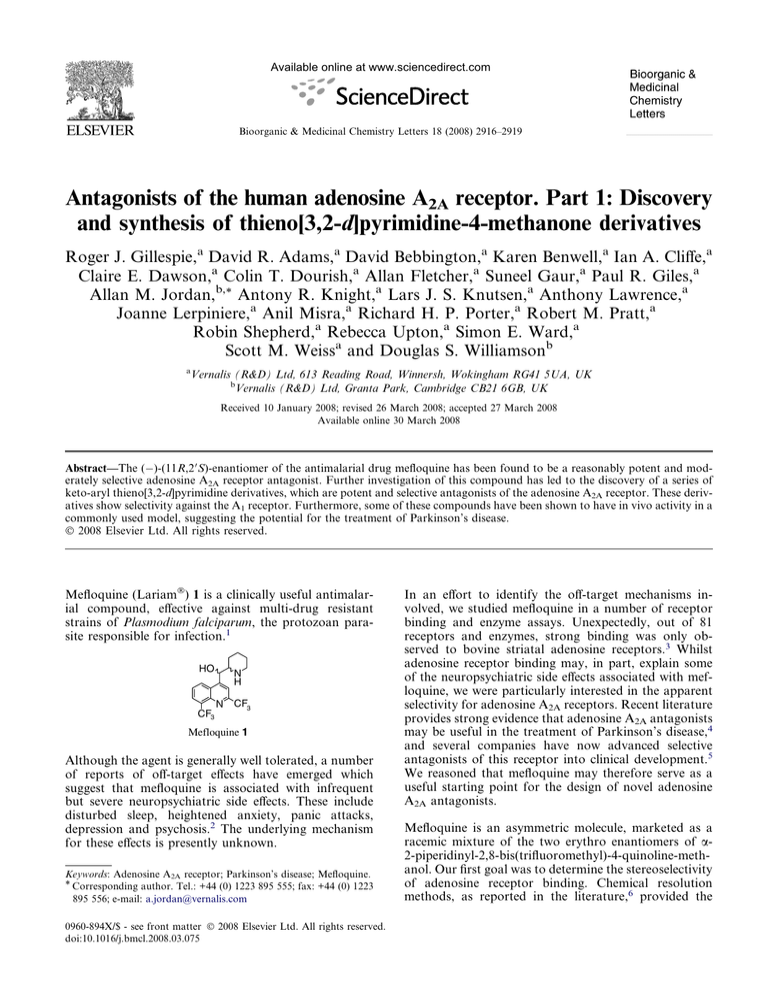
Available online at www.sciencedirect.com
Bioorganic & Medicinal Chemistry Letters 18 (2008) 2916–2919
Antagonists of the human adenosine A2A receptor. Part 1: Discovery
and synthesis of thieno[3,2-d]pyrimidine-4-methanone derivatives
Roger J. Gillespie,a David R. Adams,a David Bebbington,a Karen Benwell,a Ian A. Cliffe,a
Claire E. Dawson,a Colin T. Dourish,a Allan Fletcher,a Suneel Gaur,a Paul R. Giles,a
Allan M. Jordan,b,* Antony R. Knight,a Lars J. S. Knutsen,a Anthony Lawrence,a
Joanne Lerpiniere,a Anil Misra,a Richard H. P. Porter,a Robert M. Pratt,a
Robin Shepherd,a Rebecca Upton,a Simon E. Ward,a
Scott M. Weissa and Douglas S. Williamsonb
a
Vernalis (R&D) Ltd, 613 Reading Road, Winnersh, Wokingham RG41 5UA, UK
b
Vernalis (R&D) Ltd, Granta Park, Cambridge CB21 6GB, UK
Received 10 January 2008; revised 26 March 2008; accepted 27 March 2008
Available online 30 March 2008
Abstract—The ()-(11R,2 0 S)-enantiomer of the antimalarial drug mefloquine has been found to be a reasonably potent and moderately selective adenosine A2A receptor antagonist. Further investigation of this compound has led to the discovery of a series of
keto-aryl thieno[3,2-d]pyrimidine derivatives, which are potent and selective antagonists of the adenosine A2A receptor. These derivatives show selectivity against the A1 receptor. Furthermore, some of these compounds have been shown to have in vivo activity in a
commonly used model, suggesting the potential for the treatment of Parkinson’s disease.
Ó 2008 Elsevier Ltd. All rights reserved.
Mefloquine (LariamÒ) 1 is a clinically useful antimalarial compound, effective against multi-drug resistant
strains of Plasmodium falciparum, the protozoan parasite responsible for infection.1
HO
N
H
N
CF3
CF3
Mefloquine 1
Although the agent is generally well tolerated, a number
of reports of off-target effects have emerged which
suggest that mefloquine is associated with infrequent
but severe neuropsychiatric side effects. These include
disturbed sleep, heightened anxiety, panic attacks,
depression and psychosis.2 The underlying mechanism
for these effects is presently unknown.
Keywords: Adenosine A2A receptor; Parkinson’s disease; Mefloquine.
* Corresponding author. Tel.: +44 (0) 1223 895 555; fax: +44 (0) 1223
895 556; e-mail: a.jordan@vernalis.com
0960-894X/$ - see front matter Ó 2008 Elsevier Ltd. All rights reserved.
doi:10.1016/j.bmcl.2008.03.075
In an effort to identify the off-target mechanisms involved, we studied mefloquine in a number of receptor
binding and enzyme assays. Unexpectedly, out of 81
receptors and enzymes, strong binding was only observed to bovine striatal adenosine receptors.3 Whilst
adenosine receptor binding may, in part, explain some
of the neuropsychiatric side effects associated with mefloquine, we were particularly interested in the apparent
selectivity for adenosine A2A receptors. Recent literature
provides strong evidence that adenosine A2A antagonists
may be useful in the treatment of Parkinson’s disease,4
and several companies have now advanced selective
antagonists of this receptor into clinical development.5
We reasoned that mefloquine may therefore serve as a
useful starting point for the design of novel adenosine
A2A antagonists.
Mefloquine is an asymmetric molecule, marketed as a
racemic mixture of the two erythro enantiomers of a2-piperidinyl-2,8-bis(trifluoromethyl)-4-quinoline-methanol. Our first goal was to determine the stereoselectivity
of adenosine receptor binding. Chemical resolution
methods, as reported in the literature,6 provided the
R. J. Gillespie et al. / Bioorg. Med. Chem. Lett. 18 (2008) 2916–2919
Table 1. Human
enantiomers8
Compound
adenosine
receptor
Stereochemistry
0
(11R,2 S)
(11S,2 0 R)
(11R,2 0 R)
(11S,2 0 S)
2
3
4
5
affinity
of
mefloquine
A2A Ki (nM)
A1 Ki (nM)
61
6553
124
2534
255
14,044
1221
8607
2917
a Ki of 90 nM at the A2A receptor, a dramatic 35-fold
improvement, though selectivity over the A1 receptor
was reduced somewhat, to 15-fold.
O
S
N
CF3
N
9
two erythro and two threo enantiomers, which were
evaluated in binding studies at human adenosine receptors. (It is worthy of note, however, that the absolute
stereochemistry described in the literature is incorrect
and is the subject of a recent structural correction paper.7) As shown in Table 1, A2A receptor affinity resides
predominantly in enantiomers having 11R stereochemistry and in particular in the ()-(11R,2 0 S) isomer 2.
2'
HO
11
N
CF3
N
H
CF3
(11R, 2’S)-Mefloquine 2
Despite extensive SAR studies of a series of related quinoline derivatives, we found it difficult to improve upon
the overall profile of 2, with the majority of modifications leading to diminished potency at the A2A receptor.
However, these studies highlighted two key findings.
Firstly, we determined that the basic nitrogen of the
piperidine ring was not explicitly required for potency.
Secondly, it appeared that the piperidine ring itself appeared to be fulfilling a hydrophobic interaction with
the receptor, which could be mimicked by the incorporation of a carbocyclic ring.9
The next stage of our investigation was to assess the impact of altering the central scaffold. In particular, we
considered it likely that the introduction of a central
core with reduced lipophilicity, compared to quinoline,
might lead to improved drug-like properties.
The introduction of an additional nitrogen atom into
quinoline 6 (A2A Ki 9524 nM, A1 Ki 16,500 nM) led to
quinazoline 7 (A2A Ki 6493 nM, A1 Ki > 100,000 nM).
Investigation into changes in the A-ring of the biaryl
system revealed that the thieno[3,2-d]pyrimidine scaffold
(compound 8) showed both improved potency at A2A
(A2A Ki 3055 nM) and promising selectivity over
A1(Ki > 100,000 nM).
HO
HO
HO
S
N
N
6
CF3
N
7
CF3
N
N
8
CF3
These compounds were prepared by the reduction of the
corresponding keto-precursors (see below for details).
During the routine screening of these intermediates,
compound 9, the keto-precursor of 8, was shown to have
This finding prompted further investigation, and a series
of arylketone analogues of 9 were prepared and evaluated. A representative selection of these derivatives is described in Table 2. Pleasingly, these highly active
compounds were now both achiral and synthetically easier to access than the corresponding hydroxyl
conjoiners.
Gratifyingly, low nanomolar potencies and reasonable
selectivities were observed in a number of compounds
in this series. The most potent compounds arose by
the replacement of the phenyl group in compound 9
with the 5-membered, electron-rich groups thiophene
and furan, as in compounds 14, 16, 17 and 18. A corresponding reduction in affinity associated with the use of
pyridyl substituents, as in compounds 10, 11 and 12,
supports the hypothesis that electron-rich groups are favoured in this position.
Based on these data, the 2-thienyl substituent in compound 14 was selected as a fixed substituent in efforts towards the optimisation of the C-2 substituent. The
results from these studies are described in Table 3.
The data in Table 3 show that a range of C-2 substituents are tolerated and provide compounds with good
A2A potency. A reasonable degree of selectivity for
A2A over A1 is maintained by small alkyl and some
alkylamino substituents.
As part of our investigation into the potential of this
class of compound as anti-Parkinsonian agents, we
Table 2. Binding affinity of 2-trifluoromethylthieno[3,2-d]pyrimidin-4yl aryl ketones8
O R
S
N
N CF3
Compound
R
A2A Ki (nM)
A1 Ki (nM)
9
10
11
12
13
14
15
16
17
18
19
Phenyl
2-Pyridyl
3-Pyridyl
4-Pyridyl
2-Pyrrolyl
2-Thienyl
3-Thienyl
2-Furyl
3-Furyl
5-Methyl-2-furyl
2-Thiazolyl
92
5737
435
1384
118
11
56
33
30
22
335
1364
17,514
4475
14,454
3474
430
4216
471
316
295
5462
2918
R. J. Gillespie et al. / Bioorg. Med. Chem. Lett. 18 (2008) 2916–2919
Table 3. Binding affinity of 2-substituted thieno[3,2-d]pyrimidin-4-yl
2-thienyl ketones8
O
S
S
N
R
N
Compound
R
A2A Ki (nM)
A1 Ki (nM)
14
20
21
22
23
24
25
26
27
28
29
CF3
Me
Et
OMe
NH2
NH–NH2
NHEt
NMe2
NHBn
NH(CH2)2OH
NH(CH2)3OH
11
29
16
80
23
60
25
49
25
4.3
8.1
430
487
400
710
181
33
107
1458
1733
14
32
HO
a
X
X
N
CF3
N
CF3
X = CH 6
X=N 7
X = CH, N
Scheme 1. Reagents and conditions: (a) Et2O, n-BuLi, 78 °C, 15 min,
then PhCHO, 78 °C, 1 h then rt, 51–77%.
OH
S
N
N CF3
30
a, b
Ph
O
S
c
N
N
HO
Ph
S
N
CF3
N
CF3
9
The synthesis of the compounds employed in this study
is described below.11 4-Bromo-2-trifluoromethyl-quinoline was prepared by the adaptation of literature procedures.12 Compound 6 was readily accessed by the
lithiation of the corresponding quinoline followed by
reaction with benzaldehyde to give the racemic benzyl
alcohol as depicted in Scheme 1. Similarly, compound
7 was prepared from the corresponding 4-bromoquinazoline.
Compound 8 was prepared from 4-hydroxythienopyrimidine 30.13 Chlorination with phosphorous oxychloride
was followed by aldehyde incorporation catalysed by
N,N-dimethylimidazolium chloride,14 to give the ketoaryl compound 9. The alcohol was then obtained by facile
reduction with sodium borohydride (Scheme 2).
tested a selection of compounds in vivo in the haloperidol-induced hypolocomotion model in mice.10 In this
model, the reduction in locomotor activity induced by
the D2 antagonist haloperidol can be reversed by the
subsequent administration of an adenosine A2A antagonist. This model can be used as a measure of A2A antagonist effects in vivo. In this assay, a number of
thieno[3,2-d]pyrimidine analogues showed modest
in vivo effects. In particular, compounds 24, 25, 28
Br
and 29 were shown to be active following intraperitoneal
administration at 30 mg/kg.
8
Scheme 2. Reagents and conditions: (a) POCl3, reflux, 2 h, 35%; (b)
PhCHO, N,N-dimethylimidazolium iodide, NaH, THF, reflux, 15 min,
21%; (c) NaBH4, MeOH, rt, 1 h, 27%.
Compounds 10–19 were prepared in a manner similar to
compound 9 in Scheme 2, by employing the appropriate
aldehyde.
The C-2 alkyl derivatives 20 and 21, detailed in Table 3,
were prepared in a related manner, though the precursor
2-alkyl-4-chlorothienopyrimidines required bespoke
synthesis from aminothiophene 31, as detailed in
Scheme 3. N-Acylation of 31 with the appropriate alkyl
anhydride introduced the desired aliphatic moiety and
the resultant bis-amide was cyclised under basic conditions then converted to the corresponding 4-chlorothienopyrimidine with phosphorous oxychloride. The
thiophene ketone moiety was then introduced via the
aforementioned N,N-dimethylimidazolium iodide-mediated coupling.14
The methoxy derivative 22 was prepared from methyl 3aminothiophene-2-carboxylate 32, as shown in Scheme
4. Cyclisation with urea gave the dihydroxy thienopyrimidine 33, which was converted to the bis-chloro derivative 34 using phenylphosphonic dichloride. Again,
aldehyde incorporation was mediated by N,N-dimethylimidazolium chloride14 to yield the keto-aryl compound
35 and the displacement of the 2-chloro was achieved
with a refluxing solution of sodium methoxide. Similarly, the amino derivatives 23–29 were prepared by
treating 35 with the appropriate amine in refluxing
ethanol.
In summary, we report herein the discovery of a novel
class of adenosine A2A antagonists. Through iterative
medicinal chemistry, we have demonstrated that 4-keto-
O
O
S
NH2
NH2
31
a
NH2 b, c
S
NH
O
R
Cl
S
N
O
d
N
S
R
S
N
N R
20, 21
Scheme 3. Reagents and conditions: (a) (RCO)2O, PhCH3, NEt3, reflux, 1.5 h, 80–82%; (b) NaOH, reflux, 4 h, 100%; (c) POCl3, reflux, 4 h, 72–92%;
(d) thiophene-2-carboxaldehyde, N,N-dimethylimidazolium iodide, NaH, THF, reflux, 15 min, 54–66%.
R. J. Gillespie et al. / Bioorg. Med. Chem. Lett. 18 (2008) 2916–2919
O
S
OMe
a
OH
S
N
N
NH2
32
b
Cl
S
N
OH
33
4.
Cl
N
34
c
O
S
S
O
d
N
N
R
22-29
5.
S
S
N
N
Cl
35
Scheme 4. Reagents and conditions: (a) Urea, 200 °C, 4 h, 83%; (b)
PhPOCl2, 170 °C, 2 h, 66%; (c) thiophene-2-carboxaldehyde, N,Ndimethylimidazolium iodide, NaH, THF, reflux, 15 min, 46%; (d)
(compound 22) sodium methoxide, reflux, 18 h, 90%; (e) (compounds
23–29) NHR1R2, EtOH, reflux, 2 h, 37–68%.
6.
7.
8.
arylthieno[3,2-d]pyrimidine derivatives show strong
antagonism of the human adenosine A2A receptor and
selectivity against the A1 receptor. Furthermore, some
of these compounds have demonstrated activity in a
commonly used in vivo model predictive of potential
utility for the treatment of Parkinson’s disease.
9.
10.
References and notes
1. Palmer, K. J.; Holliday, S. M.; Brogden, R. N. Drugs
1993, 45, 430.
2. See, for example Weinke, T.; Trautmann, M.; Held, T.;
Weber, G.; Eichenlaub, D.; Fleischer, K.; Kern, W.;
Pohle, H. D. Am. J. Trop. Med. Hyg. 1991, 45, 86; van
Riemsdijk, M. M.; van der Klauw, M. M.; van Heest, J.
A.; Reedeker, F. R.; Ligthelm, R. J.; Herings, R. M.;
Stricker, B. H. Eur. J. Clin. Pharmacol. 1997, 52, 1.
3. Weiss, S. M.; Benwell, K.; Cliffe, I. A.; Gillespie, R. J.;
Knight, A. R.; Lerpiniere, J.; Misra, A.; Pratt, R. M.;
11.
12.
13.
14.
2919
Revell, D.; Upton, R.; Dourish, C. T. Neurology 2003, 61,
S101.
Xu, K.; Bastia, E.; Schwarzschild, M. Pharmacol. Ther.
2005, 105, 267; Cristalli, G.; Cacciari, B.; Dal Ben, D.;
Lambertucci, C.; Moro, S.; Spalluto, G.; Volpini, R.
Chem. Med. Chem. 2007, 2, 260.
Neustadt, B. R.; Hao, J.; Lindo, N.; Greenlee, W. J.;
Stamford, A. W.; Tulshian, D.; Ongini, E.; Hunter, J.;
Monopoli, A.; Bertorelli, R.; Foster, C.; Arik, L.; Lachowicz, J.; Ng, K.; Feng, K.-I. Bioorg. Med. Chem. Lett.
2007, 17, 1376; Neustadt, B.; Hao, J.; Lindo, N.; Greenlee,
W. J.; Stamford, A. W.; Ongini, E.; Hunter, J.; Monopoli,
A.; Bertorelli, R.; Fredduzzi, S.; Impagnatiello, F.; Foster,
C.; Arik, L.; Lachowicz, J.; Ng, K.; White, R.; Feng, K. I.;
Hesk, D. Abstracts of Papers, 231st ACS National
Meeting, Atlanta, GA, United States, March 26–30,
2006, MEDI-204; <http://www.kyowa.co.jp/eng/netext/
er070427_02.htm/>.
Carroll, F. I.; Blackwell, J. T. J. Med. Chem. 1974, 17, 210.
Lutz, R. E.; Ohnmacht, C. J.; Patel, A. R. J. Med. Chem.
1971, 14, 926.
For details of Ki determination, see Ref. 3. All values are
the mean of at least three separate values.
Data not shown. Binding affinity data for representative
derivatives against the human A2A receptor can be found
in Gillespie, R. J.; Lerpiniere, J.; Gaur, S.; Adams, D. R.;
Knutsen, L. J. S.; Ward, S. E. PCT Int. Appl.
WO200013681, 2000; Gillespie, R. J.; Lerpiniere, J.; Giles,
P. R.; Adams, D. R.; Knutsen, L. J. S.; Cliffe, I. A. PCT
Int. Appl. WO200013682, 2000.
Bezard, E.; Imbert, C.; Gross, C. E. Rev. Neurosci. 1998, 9,
71; Mandhane, S. N.; Chopde, C. T.; Ghosh, A. K. Eur. J.
Pharmacol. 1997, 328, 135.
Synthetic procedures are described in more detail in
Gillespie, R. J.; Giles, P. R.; Lerpiniere, J.; Dawson, C. E.;
Bebbington, D. PCT Int. Appl. WO200102409, 2001 and
Ref. 9.
See, for example Pinder, R. M.; Burger, A. J. Med. Chem.
1968, 11, 267; Osborne, A. G.; Miller, L. A. D. J. Chem.
Soc., Perkin Trans. 1 1993, 181.
Primeau, J. L.; Garrick, L. M. U.S. 5187168, 1993.
Miyashita, A.; Obae, K.; Suzuki, Y.; Oishi, E.; Iwamoto,
K.; Higashino, T. Heterocycles 1997, 45, 2159.





